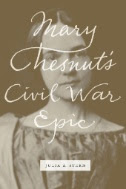A search for the subject
'diary' in our
catalog pulled up six titles. Five are electronic books. The compare and contrast comes in because two titles are offered in two electronic formats, Ebsco and ebrary.

I've talked about the differences between the two vendors. This gives us a chance to compare and contrast with the same content. I selected
Mary Chesnut's Civil War epic as the book to compare.
- To open the Ebsco version, you click on the
ebook full text link on the left. Don't click on the book cover on the right.
- The ebrary version opens with no extra steps.
One less step to get to the content, sets ebrary ahead in terms of ease of use.
- To search in Ebsco, after the book is open, the tool bar on the right has a magnifying glass icon at the top. Select that icon and a search bar appears above the contents.
- To search in ebrary, the search box for the document is visible above the right column that contains the links to move through the book.
No extra steps needed to search through the text in ebrary.
- To cite the book, Ebsco has a citation link which gives you APA, MLA, etc formatted citations
- There are no formatted citations in ebrary. They do give you the information you need at the bottom of the right hand column to create your citation. In My Settings, they offer the option to use 2 outside vendors to create a citation.
Here Ebsco definitely makes it easy.
- Ebsco offers the option to e-mail the citation and up to 60 pages of text .
- ebrary does not seem to have an e-mail option.
Here Ebsco leads the way.
- Ebsco offers download information for an e-reader
- ebrary offers download information for a pdf file for this title
Neither has an advantage in this area.
-Ebsco has a print icon in the tool list on the right side of the screen.
-ebrary has a print option when you click on Info Tools on the upper left side.
Ebsco makes the print option obvious.
- Ebsco has a create note icon that opens a word document above the text. I see how I can save the notes and print the notes but not how to e-mail the notes.
- ebrary has a bookshelf where you can place books for future reference.
ebrary has a highlighter feature that allows you to mark passages for future reference
This seems like a draw.
Both vendors offer a service that is invaluable- 24/7 access to books. Ebsco excells in a few areas. ebrary excells in a few areas. I prefer the look of Ebsco. I prefer the e-mail options available in Ebsco. Which works best for you?
To access the electronic books off campus, you will need to use a log in.
As of February 14th, you may find all the logins through our
catalog.
Put your student ID and password in upper right corner boxes.
.. Select My Account.
.....Select the Off Campus Access link.
Scroll to the bottom for the Electronic Books section.
-kss



































